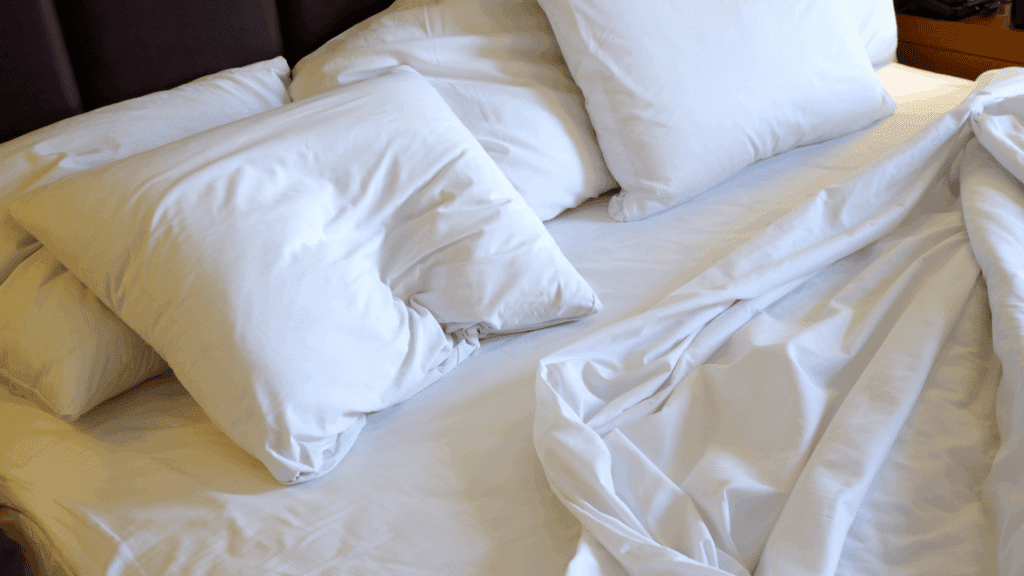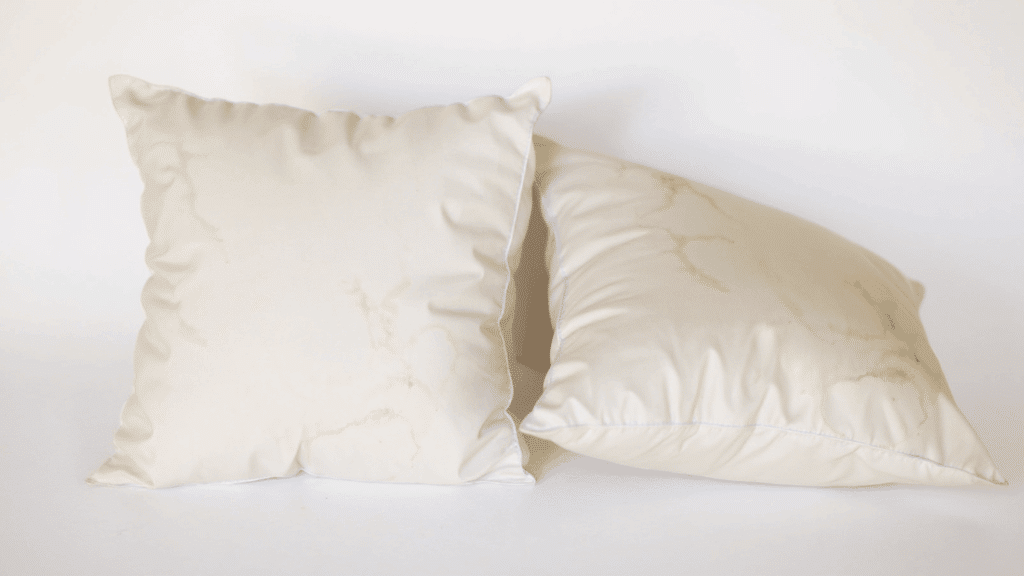Have you ever flipped your pillow over and noticed those unsightly yellow stains? It’s a common sight in many bedrooms, and honestly, it can be pretty gross.
Those yellow stains aren’t just about dirt or poor hygiene. They’re actually caused by a mix of natural body oils, sweat, and even the products people use on their skin and hair.
Understanding why this happens can help anyone keep their pillows fresher for longer.
This article will break down the real reasons behind pillow yellowing and share simple, practical ways to prevent it from happening in the first place.
The Science Behind Yellow Pillow Stains
Yellow pillow stains are more than just an eyesore. They’re the result of a chemical process that happens night after night.
When people sleep, their bodies naturally release sweat and oils through the skin. These substances seep into the pillow fabric and fill over time.
The yellowing occurs when these body fluids oxidize, similar to how a cut apple turns brown when exposed to air. Moisture plays a big role, too.
Add in traces of saliva, skincare products, and hair oils, and the discoloration becomes even more noticeable. It’s a natural process that affects everyone’s pillows eventually.
Reasons Why Your Pillow is Turning Yellow

Understanding these causes can help people tackle the problem at its source and keep their pillows looking cleaner for longer.
1. Sweat and Body Oils
Every night, the body produces sweat and natural oils, even during the coolest months. These fluids don’t just evaporate into thin air.
They soak directly into the pillow fabric and padding. Over weeks and months, this accumulation creates yellow stains that spread across the surface.
The warmth from a person’s head speeds up this process, making the oils penetrate deeper into the pillow’s core layers.
2. Saliva and Drool
Many people drool while sleeping, especially side sleepers and those who sleep with their mouths open.
Saliva contains enzymes and proteins that leave stubborn stains when they dry. These wet spots create perfect conditions for bacterial growth, too.
The combination of moisture and organic matter accelerates yellowing in specific areas. Even occasional drooling can cause noticeable discoloration over time if pillows aren’t cleaned regularly.
3. Skincare and Hair Products
Nighttime beauty routines often include moisturizers, serums, hair oils, and leave-in conditioners. While these products work wonders for skin and hair, they transfer onto pillows throughout the night.
Many contain ingredients that don’t wash out easily and can permanently stain fabric.
Hair products are particularly problematic since wet or damp hair releases more product onto the pillow surface. These residues build up quickly and contribute significantly to yellowing.
4. Dust Mites and Allergens
Pillows become home to millions of dust mites that feed on dead skin cells. These tiny creatures leave behind waste products that mix with other substances in the pillow.
Their presence, combined with environmental allergens like pollen, creates a layer of residue that discolors fabric over time. This buildup can affect sleep quality in sensitive individuals.
Health Risks of Yellow Pillows You Can’t Ignore
Yellow pillows aren’t just unappealing to look at; they can also pose serious health risks, affecting sleep quality and overall well-being.
- Allergic Reactions and Respiratory Issues: Dust mites thrive in old, stained pillows, and their waste can trigger sneezing, a runny nose, and itchy eyes. People with asthma may experience more frequent attacks when sleeping on contaminated pillows.
- Skin Breakouts and Irritation: Bacteria and oils trapped in yellow pillows can clog pores, leading to acne flare-ups. The dirty surface constantly rubs against facial skin, leading to inflammation and irritation throughout the night.
- Fungal and Bacterial Growth: Moisture from sweat creates the perfect breeding ground for mold and bacteria. These microorganisms can cause infections, especially for people with weakened immune systems or sensitive skin.
- Poor Sleep Quality: The accumulation of allergens and unpleasant odors disrupts restful sleep. People may wake up with headaches, congestion, or feeling less refreshed than they should after a full night’s rest.
- Worsening of Existing Conditions: Those with eczema, psoriasis, or other skin conditions may notice their symptoms getting worse. The contaminated pillow surface constantly irritates already sensitive skin and prevents proper healing.
How to Prevent Your Pillow from Turning Yellow

Prevention is always easier than removing stubborn yellow stains later. Taking a few simple steps can keep pillows looking fresh and extend their lifespan significantly.
1. Use Pillow Protectors
Pillow protectors act as a barrier between the pillow and all those body fluids and oils. These covers are typically waterproof or water-resistant, blocking sweat and moisture from seeping through.
They’re easy to wash and much more affordable than replacing entire pillows. Plus, they add an extra layer of comfort and help keep allergens at bay.
2. Wash Pillowcases Regularly
Pillowcases should be washed at least once a week, or even more frequently for people with oily skin or hair.
Regular washing removes the daily buildup of oils, sweat, and product residue before they penetrate deeper. Using hot water kills bacteria and dust mites more effectively.
3. Clean Pillows Every Few Months
Most pillows can be machine-washed, but it’s important to check the care label first. Washing pillows every three to four months removes accumulated oils and allergens from the filling itself.
Using a gentle cycle with mild detergent works best. Make sure to dry them completely to prevent mold growth.
4. Shower Before Bed
Going to bed with clean skin and hair significantly reduces the amount of oil and product transfer. A quick rinse removes the day’s dirt, sweat, and styling products that would otherwise end up on the pillow.
This is especially important for people who use heavy moisturizers or hair treatments. It’s a healthy habit that benefits both skin and bedding.
5. Avoid Applying Heavy Products Before Sleep
While nighttime skincare is important, using lighter products can prevent pillow staining. Heavy creams, oils, and serums take longer to absorb and are more likely to transfer onto fabric.
If heavier products are necessary, give them extra time to sink in before lying down. Alternatively, apply them earlier in the evening to avoid going to sleep with the products.
Quick Fixes to Whiten Yellowed Pillows at Home
If pillows have already turned yellow, don’t panic. There are several effective home remedies that can restore their original white color without harsh chemicals.
These methods use common household items and are gentle enough for most pillow types.
1. Baking Soda and Vinegar Soak: Mix half a cup of baking soda with vinegar in warm water, soak the pillow for an hour, then wash as usual to lift stains naturally.
2. Lemon Juice and Sun Treatment: Add lemon juice to the wash cycle and dry pillows in direct sunlight, as the combination acts as a natural bleaching agent.
3. Hydrogen Peroxide and Dish Soap: Combine hydrogen peroxide with a small amount of dish soap in the washing machine to break down tough protein-based stains effectively.
4. Borax Booster Wash: Add half a cup of borax to the regular laundry detergent during the wash cycle to enhance stain removal and brighten fabric.
5. Hot Water Deep Clean: Wash pillows in the hottest water safe for the fabric with extra detergent, then run an additional rinse cycle to ensure all residue is removed.
Signs it’s Time to Change Your Pillows
Even with the best care, pillows don’t last forever. Most experts recommend replacing them every one to two years, depending on quality and usage.
There are clear signs that indicate when a pillow has reached the end of its life. If the yellow stains won’t come out despite multiple washings, it’s time for a new one.
Pillows that have lost their shape or feel lumpy no longer provide proper support.
A simple fold test can help: fold the pillow in half, and if it doesn’t spring back, replace it. Persistent odors and waking up with neck pain are other red flags.
To Conclude
Keeping pillows white and fresh doesn’t have to be complicated. Simple habits go a long way in preventing those stubborn yellow stains.
When discoloration does happen, home remedies can often restore pillows to their original condition.
Paying attention to warning signs like persistent odors, loss of shape, or neck discomfort means it’s time to invest in new pillows.
A clean pillow isn’t just about aesthetics; it’s about breathing easier, sleeping better, and waking up refreshed every single morning.

